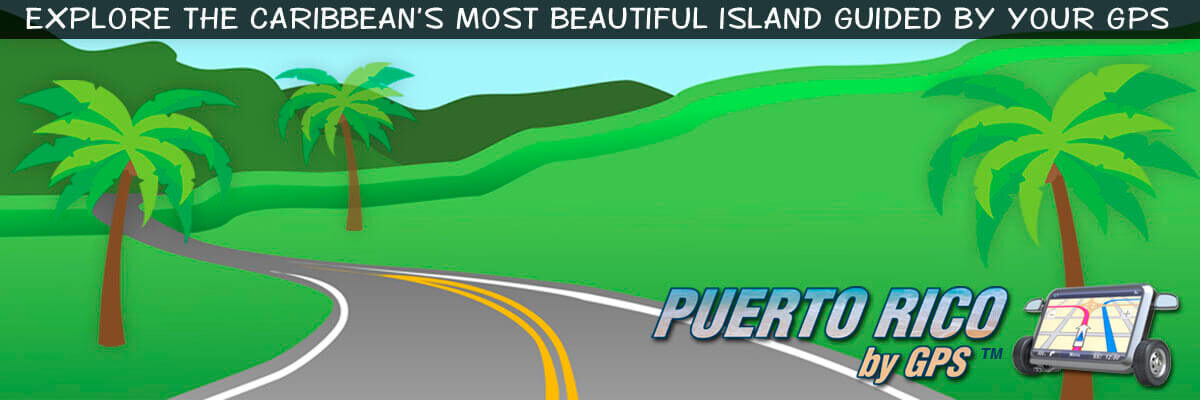Harvey Deegan Interview Click here to listen to the interview!
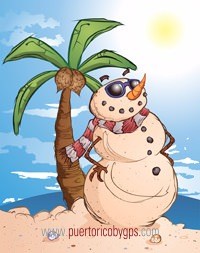
Instead of a snowman you can make a sandman in 80° weather.
Today I had a unique experience. I spoke about Puerto Rican Christmas traditions to an audience that’s mostly on the other side of the planet. That’s right, this morning I had the rare opportunity to speak with Harvey Deegan, a radio personality with Radio 6PR in Perth, Western Australia.
This is the second time that I’ve been invited to speak to an Australian audience. The first time I spoke for close to an hour with Steve Collins, who produces a show called “Radio Roaming”. Click here if you would like to read the post and listen to that interview.
For many years I thought that the Puerto Rican Christmas season was the longest in the world, but Wikipedia proved me wrong. It’s actually the Philippines who holds that distinction. But who cares? I like our Christmas better. I guess you could say that I’m biased.
Like many other things in Puerto Rico Christmas brings together a variety of cultures and traditions. The Island was originally inhabited by the Taíno indians who had a predominantly vegetarian diet.
With the Spaniards and the Africans came potatoes, plantains, olives, wheat, coconuts, sugar cane, pork, beef, chicken and a variety of spices like pepper, oregano and parsley.
And what about the American diet? That too has been greatly influential on the Puerto Rican diet but not so much when it comes to Christmas food. That’s mainly a mixture of Taíno, Spaniard and African influences.
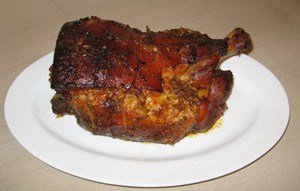
Roasted Pork
Take for example the typical Christmas dinner. You can expect a big piece of roasted pork, rice with pigeon peas, blood sausage, pickled green bananas and “pasteles” (all on the same plate).
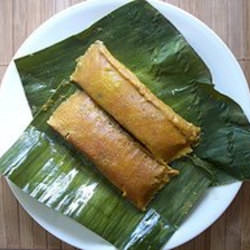
Pasteles
“Pasteles” are made of “masa” and meat filling. “Masa” is made of grated “yautías” (a type of root that we inherited from the Taínos), green bananas, some green plantain (both of which we inherited from Africa) and pumpkin (which we inherited from Spain). Some people add a little bit of milk to make it smoother. The meat filling is made of stewed pork meat (also inherited from Spain). Finally, they are wrapped in banana leaves and boiled to perfection.
For dessert you can have some “arroz con dulce” (rice pudding), “tembleque” (a type of coconut pudding that has a consistency similar to jello) or “majarete” (a thick cream made of rice flour and coconut).
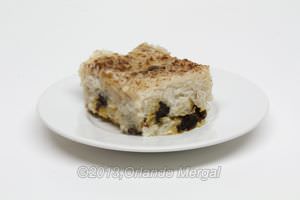
Arroz con dulce (Rice Pudding)
And to wash it all down you can simply have water, a regular soda or better yet some “coquito” (a thick white beverage made of coconut milk, cinnamon and rum). Most of the time your “coquito” will be made with one of the many legal rums that are produced on the Island, but if you’re really lucky it will be made with “pitorro” the illegal variety that always seems to surface during the Christmas season.
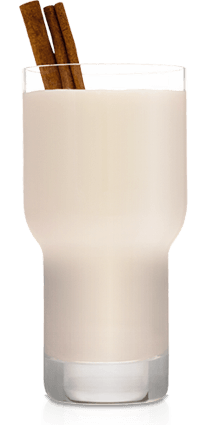
Coquito
So how long is Christmas in Puerto Rico? Well, it’s basically two months long. It all kicks off on Thanksgiving Day and ends with the San Sebastian Street Fiestas on the third weekend of January.
Thanksgiving Day is a wonderful tradition that Puerto Ricans inherited from the United States when they invaded the Island in 1898. Of course, islanders have “puertoricanized” the bird quite a bit. They season it with salt, pepper and oregano, and many stuff it with “mofongo” (mashed plantains with garlic and “chicharrón” (roasted hog’s lard)). Yum!
The period between Thanksgiving Day and “Nochebuena” (Christmas Eve) is when Puerto Ricans tend to show how “Americanized” they really are. One such American tradition that has really caught on in Puerto Rico is Black Friday, in which people stand in line for hours to be among the first to enter the department store of their choice at midnight. Personally I find that this practice is irrational and it exemplifies one of the ugliest sides of capitalism.
 December is all about Santa. The jolly old guy really takes over the stores and many people fall prey to the Christmas craze. Plastic runs wild during this period and you can expect crowded stores, long lines and very few parking spaces.
December is all about Santa. The jolly old guy really takes over the stores and many people fall prey to the Christmas craze. Plastic runs wild during this period and you can expect crowded stores, long lines and very few parking spaces.
But all this craze is on the commercial front. On the “people” front it’s a totally different story. Puerto Ricans love to party and Christmas is when they do it the most.
One tradition that refuses to die is “parrandas” in which a group of friends (many of which are musicians) gets together to visit other friends and family all through the night and wake them to the tune of Puerto Rican Christmas music. Personally, I play the guitar, and I used to participate in “parrandas” quite a lot when I was a young man. But the proliferation of gated communities in the San Juan Metroplex has taken its toll on “parrandas” (there’s no longer the element of surprise) and today they mainly take place in the smaller inner island towns.
Even so, Christmas is a time when friends and family get together to eat Christmas food, drink (sometimes more than they should), listen to music and enjoy the company of good people.
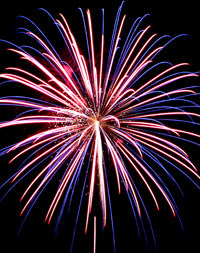 After Christmas day the next big event is New Year’s Eve and New Year’s Day. There’s nothing very different here except one thing: some people find it amusing to shoot their weapons into the sky and —as you might imagine— this has led to random injuries in the past.
After Christmas day the next big event is New Year’s Eve and New Year’s Day. There’s nothing very different here except one thing: some people find it amusing to shoot their weapons into the sky and —as you might imagine— this has led to random injuries in the past.
Normally other tourism blogs might not mention this sort of thing because they fear it might scare tourists away. But remember, in Puerto Rico By GPS we tell it like it is. I should also say that the Island’s government has taken a firm stance against this practice and in recent years it has been a lot less prevalent.
Even so, in Puerto Rico most houses are made of concrete and I have always insisted that every member of my family spend the last half hour of the year and the first half hour of the coming year under a concrete roof.
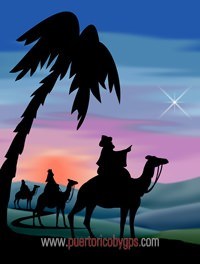
The Three Wise Men
The first six days of January lead to the celebration of “El Día De Los Tres Reyes Magos” (the three wise men day). Puerto Rico inherited this tradition from Spain and it has been an official holiday since 1885. It has its origins in the Old Testament and the story of the group of distinguished foreigners who visited Jesus after his birth, bearing gifts of gold, frankincense and myrrh.
This tradition is also an official holiday in Spain and in other Latin American countries like Mexico, the Dominican Republic, Paraguay, Uruguay, Colombia and Venezuela.
By this time of year most Americans will be back at work trying to get rid of those extra pounds that they gained during the Christmas season. Many Puerto Ricans will also be trying to lose weight but there will still be plenty of partying going on.
After January 6th Christmas is officially over in Puerto Rico but many Islanders squeeze in eight more days that they call “las octavitas”. Like many other Christmas traditions on the Island “las octavitas” have their roots in Catholic faith but today they’ve simply evolved into one more reason to party.
And then there’s “Las Fiestas De La Calle San Sebastian”. This four day event brings together thousands and thousands of people on a one-lane street in Old San Juan. “Las Fiestas De La Calle San Sebastian” were started by father Juan Manuel Madrazo and Mrs. Rafaela Balladares as a fundraiser for the “Colegio de Párvulos”, a small school on the western end of San Sebastian Street.
Later on it grew into what it is today: an artisan fair with food, lots of alcoholic beverages, music and so many people that it’s even hard to walk. You simply move with the masses. It has become the largest outdoor event in the world taking place during the month of January.
So there you have it. It all starts with an innocent turkey and it grows and grows into one of the largest parties in the world. And all this with an average temperature of 80° Farenheit. Isn’t it great!
So if you’re looking for a place to have some fun in the sun this Christmas, instead of enduring those nasty cold fronts that the weatherman is forecasting, come over to sunny Puerto Rico.
Merry Christmas,
©2014,Orlando Mergal, MA
____________________
Bilingual Content Creator, Blogger, Podcaster,
Author, Photographer and New Media Expert
Tel. 787–750-0000, Mobile 787–306-1590
